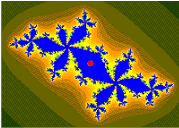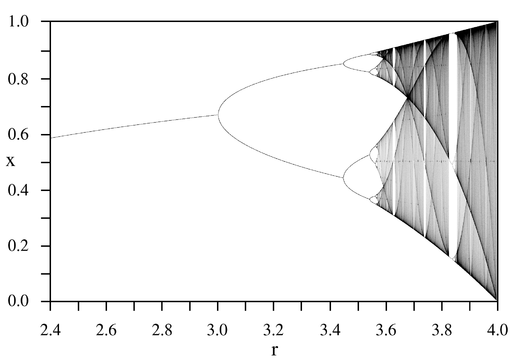Ivar Ekeland
Ivar I. Ekeland (born 2 July 1944, Paris) is a French mathematician of Norwegian descent. Ekeland has written influential monographs and textbooks on nonlinear functional analysis, the calculus of variations, and mathematical economics, as well as popular books on mathematics, which have been published in French, English, and other languages. Ekeland is known as the author of Ekeland's variational principle and for his use of the Shapley–Folkman lemma in optimization theory. He has contributed to the periodic solutions of Hamiltonian systems and particularly to the theory of Kreĭn indices for linear systems (Floquet theory).[4] Ekeland helped to inspire the discussion of chaos theory in Michael Crichton's 1990 novel Jurassic Park.[3]

Biography
Ekeland studied at the École Normale Supérieure (1963–1967). He is a senior research fellow at the French National Centre for Scientific Research (CNRS). He obtained his doctorate in 1970. He teaches mathematics and economics at the Paris Dauphine University, the École Polytechnique, the École Spéciale Militaire de Saint-Cyr, and the University of British Columbia in Vancouver. He was the chairman of Paris-Dauphine University from 1989 to 1994.
Ekeland is a recipient of the D'Alembert Prize and the Jean Rostand prize. He is also a member of the Norwegian Academy of Science and Letters.[5]
Popular science: Jurassic Park by Crichton and Spielberg

Ekeland has written several books on popular science, in which he has explained parts of dynamical systems, chaos theory, and probability theory.[1][7][8] These books were first written in French and then translated into English and other languages, where they received praise for their mathematical accuracy as well as their value as literature and as entertainment.[1]
Through these writings, Ekeland had an influence on Jurassic Park, on both the novel and film. Ekeland's Mathematics and the unexpected and James Gleick's Chaos inspired the discussions of chaos theory in the novel Jurassic Park by Michael Crichton.[3] When the novel was adapted for the film Jurassic Park by Steven Spielberg, Ekeland and Gleick were consulted by the actor Jeff Goldblum as he prepared to play the mathematician specializing in chaos theory.[6]
Research
Ekeland has contributed to mathematical analysis, particularly to variational calculus and mathematical optimization.
Variational principle
In mathematical analysis, Ekeland's variational principle, discovered by Ivar Ekeland,[9][10][11] is a theorem that asserts that there exist a nearly optimal solution to a class of optimization problems.[12]
Ekeland's variational principle can be used when the lower level set of a minimization problems is not compact, so that the Bolzano–Weierstrass theorem can not be applied. Ekeland's principle relies on the completeness of the metric space.[13]
Ekeland's principle leads to a quick proof of the Caristi fixed point theorem.[13][14]
Ekeland was associated with the University of Paris when he proposed this theorem.[9]
Variational theory of Hamiltonian systems
Ivar Ekeland is an expert on variational analysis, which studies mathematical optimization of spaces of functions. His research on periodic solutions of Hamiltonian systems and particularly to the theory of Kreĭn indices for linear systems (Floquet theory) was described in his monograph.[4]
Additive optimization problems

Ekeland explained the success of methods of convex minimization on large problems that appeared to be non-convex. In many optimization problems, the objective function f are separable, that is, the sum of many summand-functions each with its own argument:
For example, problems of linear optimization are separable. For a separable problem, we consider an optimal solution
with the minimum value f(xmin). For a separable problem, we consider an optimal solution (xmin, f(xmin)) to the "convexified problem", where convex hulls are taken of the graphs of the summand functions. Such an optimal solution is the limit of a sequence of points in the convexified problem
- [15][16] An application of the Shapley–Folkman lemma represents the given optimal-point as a sum of points in the graphs of the original summands and of a small number of convexified summands.
This analysis was published by Ivar Ekeland in 1974 to explain the apparent convexity of separable problems with many summands, despite the non-convexity of the summand problems. In 1973, the young mathematician Claude Lemaréchal was surprised by his success with convex minimization methods on problems that were known to be non-convex.[17][15][18] Ekeland's analysis explained the success of methods of convex minimization on large and separable problems, despite the non-convexities of the summand functions.[15][18][19] The Shapley–Folkman lemma has encouraged the use of methods of convex minimization on other applications with sums of many functions.[15][20][21][22]
Bibliography
Research
- Ekeland, Ivar; Temam, Roger (1999). Convex analysis and variational problems. Classics in applied mathematics. 28. Philadelphia, PA: Society for Industrial and Applied Mathematics (SIAM). ISBN 978-0-89871-450-0. MR 1727362.CS1 maint: ref=harv (link) (Corrected reprinting of the 1976 North-Holland (MR463993) ed.)
- The book is cited over 500 times in MathSciNet.
- Ekeland, Ivar (1979). "Nonconvex minimization problems". Bulletin of the American Mathematical Society. New Series. 1 (3): 443–474. doi:10.1090/S0273-0979-1979-14595-6. MR 0526967.CS1 maint: ref=harv (link)
- Ekeland, Ivar (1990). Convexity methods in Hamiltonian mechanics. Ergebnisse der Mathematik und ihrer Grenzgebiete (3) [Results in Mathematics and Related Areas (3)]. 19. Berlin: Springer-Verlag. pp. x+247. ISBN 978-3-540-50613-3. MR 1051888.CS1 maint: ref=harv (link)
- Aubin, Jean-Pierre; Ekeland, Ivar (2006). Applied nonlinear analysis. Mineola, NY: Dover Publications, Inc. pp. x+518. ISBN 978-0-486-45324-8. MR 2303896.CS1 maint: ref=harv (link) (Reprint of the 1984 Wiley (MR749753) ed.)
Exposition for a popular audience

- Ekeland, Ivar (1988). Mathematics and the unexpected (Translated by Ekeland from his French ed.). Chicago, IL: University Of Chicago Press. pp. xiv+146. ISBN 978-0-226-19989-4. MR 0945956.CS1 maint: ref=harv (link)
- Ekeland, Ivar (1993). The broken dice, and other mathematical tales of chance (Translated by Carol Volk from the 1991 French ed.). Chicago, IL: University of Chicago Press. pp. iv+183. ISBN 978-0-226-19991-7. MR 1243636.CS1 maint: ref=harv (link)
- Ekeland, Ivar (2006). The best of all possible worlds: Mathematics and destiny (Translated from the 2000 French ed.). Chicago, IL: University of Chicago Press. pp. iv+207. ISBN 978-0-226-19994-8. MR 2259005.CS1 maint: ref=harv (link)
See also
- Jonathan M. Borwein ("smooth" variational principle)
- Robert R. Phelps (a "grandfather" of variational principles)
- David Preiss ("smooth" variational principle)
Notes
- Ekeland (1988, Appendix 2 The Feigenbaum bifurcation, pp. 132–138) describes the chaotic behavior of the iterated logistic function, which exhibits the Feigenbaum bifurcation. A paperback edition was published: Ekeland, Ivar (1990). Mathematics and the unexpected (Paperback ed.). University Of Chicago Press. ISBN 978-0-226-19990-0.CS1 maint: ref=harv (link)
- According to Jeremy Gray, writing for Mathematical Reviews (MR945956)
- In his afterword to Jurassic Park, Crichton (1997, pp. 400) acknowledges the writings of Ekeland (and Gleick). Inside the novel, fractals are discussed on two pages, (Crichton 1997, pp. 170–171), and chaos theory on eleven pages, including pages 75, 158, and 245:
Crichton, Michael (1997). Jurassic Park. Ballantine Books. ISBN 9780345418951. Retrieved 2011-04-19.CS1 maint: ref=harv (link) - According to D. Pascali, writing for Mathematical Reviews (MR1051888)
Ekeland (1990) Ekeland, Ivar (1990). Convexity methods in Hamiltonian mechanics. Ergebnisse der Mathematik und ihrer Grenzgebiete (3) [Results in Mathematics and Related Areas (3)]. 19. Berlin: Springer-Verlag. pp. x+247. ISBN 978-3-540-50613-3. MR 1051888.CS1 maint: ref=harv (link) - "Group 1: Mathematical studies". Norwegian Academy of Science and Letters. Archived from the original on 27 September 2011. Retrieved 12 April 2011.
- Jones (1993, p. 9): Jones, Alan (August 1993). Clarke, Frederick S. (ed.). "Jurassic Park: Computer graphic dinosaurs". Cinefantastique. Frederick S. Clarke. 24 (2): 8–15. ASIN B002FZISIO. Retrieved 2011-04-12.CS1 maint: ref=harv (link)
- According to Mathematical Reviews (MR1243636) discussing Ekeland, Ivar (1993). The broken dice, and other mathematical tales of chance (Translated by Carol Volk from the 1991 French ed.). Chicago, IL: University of Chicago Press. pp. iv+183. ISBN 978-0-226-19991-7. MR 1243636.CS1 maint: ref=harv (link)
- According to Mathematical Reviews (MR2259005) discussing Ekeland, Ivar (2006). The best of all possible worlds: Mathematics and destiny (Translated from the 2000 French ed.). Chicago, IL: University of Chicago Press. pp. iv+207. ISBN 978-0-226-19994-8. MR 2259005.CS1 maint: ref=harv (link)
- Ekeland, Ivar (1974). "On the variational principle". J. Math. Anal. Appl. 47 (2): 324–353. doi:10.1016/0022-247X(74)90025-0. ISSN 0022-247X.
- Ekeland, Ivar (1979). "Nonconvex minimization problems". Bulletin of the American Mathematical Society. New Series. 1 (3): 443–474. doi:10.1090/S0273-0979-1979-14595-6. MR 0526967.CS1 maint: ref=harv (link)
- Ekeland, Ivar; Temam, Roger (1999). Convex analysis and variational problems. Classics in applied mathematics. 28 (Corrected reprinting of the (1976) North-Holland ed.). Philadelphia, PA: Society for Industrial and Applied Mathematics (SIAM). pp. 357–373. ISBN 978-0-89871-450-0. MR 1727362.CS1 maint: ref=harv (link)
- Aubin, Jean-Pierre; Ekeland, Ivar (2006). Applied nonlinear analysis (Reprint of the 1984 Wiley ed.). Mineola, NY: Dover Publications, Inc. pp. x+518. ISBN 978-0-486-45324-8. MR 2303896.CS1 maint: ref=harv (link)
- Kirk, William A.; Goebel, Kazimierz (1990). Topics in Metric Fixed Point Theory. Cambridge University Press. ISBN 978-0-521-38289-2.
- Ok, Efe (2007). "D: Continuity I" (PDF). Real Analysis with Economic Applications. Princeton University Press. p. 664. ISBN 978-0-691-11768-3. Retrieved January 31, 2009.
- (Ekeland 1999, pp. 357–359): Published in the first English edition of 1976, Ekeland's appendix proves the Shapley–Folkman lemma, also acknowledging Lemaréchal's experiments on page 373.
-
The limit of a sequence is a member of the closure of the original set, which is the smallest closed set that contains the original set. The Minkowski sum of two closed sets need not be closed, so the following inclusion can be strict
- Clos(P) + Clos(Q) ⊆ Clos( Clos(P) + Clos(Q) );
- Lemaréchal (1973, p. 38): Lemaréchal, Claude (April 1973), Utilisation de la dualité dans les problémes non convexes [Use of duality for non–convex problems] (in French), Domaine de Voluceau, Rocquencourt, 78150 Le Chesnay, France: IRIA (now INRIA), Laboratoire de recherche en informatique et automatique, p. 41CS1 maint: location (link) CS1 maint: ref=harv (link). Lemaréchal's experiments were discussed in later publications:
Aardal (1995, pp. 2–3): Aardal, Karen (March 1995). "Optima interview Claude Lemaréchal" (PDF). Optima: Mathematical Programming Society Newsletter. 45: 2–4. Retrieved 2 February 2011.CS1 maint: ref=harv (link)
Hiriart-Urruty & Lemaréchal (1993, pp. 143–145, 151, 153, and 156): Hiriart-Urruty, Jean-Baptiste; Lemaréchal, Claude (1993). "XII Abstract duality for practitioners". Convex analysis and minimization algorithms, Volume II: Advanced theory and bundle methods. Grundlehren der Mathematischen Wissenschaften [Fundamental Principles of Mathematical Sciences]. 306. Berlin: Springer-Verlag. pp. 136–193 (and bibliographical comments on pp. 334–335). ISBN 978-3-540-56852-0. MR 1295240. - Ekeland, Ivar (1974). "Une estimationa priori en programmation non convexe". Comptes Rendus Hebdomadaires des Séances de l'Académie des Sciences. Séries A et B (in French). 279: 149–151. ISSN 0151-0509. MR 0395844.CS1 maint: ref=harv (link)
- Aubin & Ekeland (1976, pp. 226, 233, 235, 238, and 241): Aubin, J. P.; Ekeland, I. (1976). "Estimates of the duality gap in nonconvex optimization". Mathematics of Operations Research. 1 (3): 225–245. doi:10.1287/moor.1.3.225. JSTOR 3689565. MR 0449695.CS1 maint: ref=harv (link)
Aubin & Ekeland (1976) and Ekeland (1999, pp. 362–364) also considered the convex closure of a problem of non-convex minimization—that is, the problem defined by the closed convex hull of the epigraph of the original problem. Their study of duality gaps was extended by Di Guglielmo to the quasiconvex closure of a non-convex minimization problem—that is, the problem defined by the closed convexhull of the lower level sets:
Di Guglielmo (1977, pp. 287–288): Di Guglielmo, F. (1977). "Nonconvex duality in multiobjective optimization". Mathematics of Operations Research. 2 (3): 285–291. doi:10.1287/moor.2.3.285. JSTOR 3689518. MR 0484418. - Aubin (2007, pp. 458–476): Aubin, Jean-Pierre (2007). "14.2 Duality in the case of non-convex integral criterion and constraints (especially 14.2.3 The Shapley–Folkman theorem, pages 463-465)". Mathematical methods of game and economic theory (Reprint with new preface of 1982 North-Holland revised English ed.). Mineola, NY: Dover Publications, Inc. pp. xxxii+616. ISBN 978-0-486-46265-3. MR 2449499.CS1 maint: ref=harv (link)
- Bertsekas (1996, pp. 364–381)acknowledging Ekeland (1999) on page 374 and Aubin & Ekeland (1976) on page 381:
Bertsekas, Dimitri P. (1996). "5.6 Large scale separable integer programming problems and the exponential method of multipliers". Constrained optimization and Lagrange multiplier methods (Reprint of (1982) Academic Press ed.). Belmont, MA: Athena Scientific. pp. xiii+395. ISBN 978-1-886529-04-5. MR 0690767.CS1 maint: ref=harv (link)
Bertsekas (1996, pp. 364–381) describes an application of Lagrangian dual methods to the scheduling of electrical power plants ("unit commitment problems"), where non-convexity appears because of integer constraints:
Bertsekas, Dimitri P.; Lauer, Gregory S.; Sandell, Nils R., Jr.; Posbergh, Thomas A. (January 1983). "Optimal short-term scheduling of large-scale power systems" (PDF). IEEE Transactions on Automatic Control. AC-28 (1): 1–11. CiteSeerX 10.1.1.158.1736. doi:10.1109/tac.1983.1103136. Retrieved 2 February 2011.CS1 maint: ref=harv (link) - Bertsekas (1999, p. 496): Bertsekas, Dimitri P. (1999). "5.1.6 Separable problems and their geometry". Nonlinear Programming (Second ed.). Cambridge, MA.: Athena Scientific. pp. 494–498. ISBN 978-1-886529-00-7.
External links
| Wikiquote has quotations related to: Ivar Ekeland |